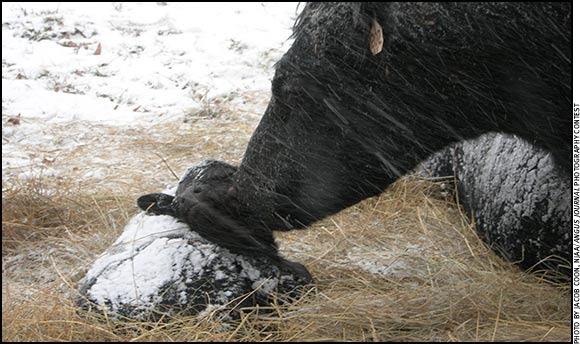HEALTH & NUTRITION...

How Cold Stress Affects Newborn Calves
Colostrum plays a critical role in cellular functions of calves.
Calves that are chilled soon after birth, without immediate assistance to warm and dry them and make sure they ingest colostrum in a timely manner, have poor survival rates. If a calf’s mouth gets cold before he suckles, he may not be able to get the teat in his mouth and suck and, therefore, he may not obtain crucial energy for keeping warm and the antibodies needed to protect against disease. Also, his ability to absorb the antibodies from colostrum diminishes as he becomes colder.
“The general consensus is that the cold calf does not have the energy for the cellular functions to work properly,” says veterinarian and University of Idaho Professor James England. “A cold calf has used up all his brown fat calories and what little bit of protein was left in the stomach (in the amniotic fluid) trying to keep warm. There isn’t enough energy for the cellular functions for transporting things back and forth in and out of the cells. The motility of the GI (gastrointestinal) tract is also impaired.” Read more.
Veterinary Feed Directive and Beyond
Veterinarian says producers need to listen and prepare for new rules.
The matter has been discussed ad nauseam in veterinarian Randall Spare’s opinion, but he fears some livestock producers still don’t get it. They need to understand that once the veterinary feed directive (VFD) rule becomes effective in 2017, some widely used animal health management practices will become illegal. While producers and their veterinarians often bristle at the idea of increased regulation, Spare said an attitude adjustment regarding the use of antibiotics is warranted. Read more.Target Weight Considerations
Whether you choose 55% or 65% of mature weight as a breeding-weight target should depend on cows, resources and management.
Both preweaning and postweaning nutrition are important to the development of replacement heifers, but most beef herd managers have more opportunity to manipulate nutrition after weaning. To help managers avoid having nutrition be a limiting factor in replacement heifers’ ability to become pregnant, the target weight concept was proposed. This gave managers a goal of having heifers reach a certain percentage of their mature weight by the beginning of the first breeding season. Read more.
Feed Value Calculator
A valuable tool used to determine the lowest-cost feed options for cattlemen.
Feed costs exceed 50% of annual beef cattle production costs, and with the current market situation, the pressure to determine the most cost-effective feedstuffs has become even more important.
South Dakota State University (SDSU) Extension has developed a feed value calculator to compare protein and energy supplement options. The spreadsheet allows producers to select supplemental feeds and compare them to baseline feeds. The benchmark for energy supplements in this spreadsheet is corn, whereas for protein supplements it is soybean meal [44% crude protein (CP)]. Read more.
Five Myths of Internal Parasite Control
Identifying the misunderstandings of parasite control.
It’s estimated that the cattle industry loses about $3 billion each year in lost weight gains, poor feed conversion and increased disease because of internal parasites.1 With the financial impact and animal welfare concerns on cattle operations, it is important for producers to understand parasite control, as well as the misconceptions about parasite control.
Here are five parasite-control myths that might be putting a producer’s management program at risk.
Myth No. 1: All active ingredients in parasite-control products have the same efficacy. Read more.
Live Oak County Fever Tick Update
Quarantine area expands.
Since the first detection of fever ticks on a Live Oak County premises in late November 2016, the Texas Animal Health Commission (TAHC) has confirmed seven additional infested premises in the county.
The additional premises were detected through systematic livestock and wildlife inspections conducted within the original Control Purpose Quarantine Area (CPQA), and the inspection of livestock moved to other premises as part of regular management practices.
As a result of detecting additional premises infested with fever ticks, the CPQA has expanded from approximately 12,587 acres on Nov. 30, 2016, to 57,541 acres.
Read more.
Steps to Developing a
Veterinarian-Client-Patient Relationship
Be prepared for the unexpected when raising animals. Develop a veterinarian-client-patient relationship.
When working with animals, just about anything can happen. Larger animals often pose a greater concern. 4-H members are encouraged to think about the larger picture of animal care and well-being in their management strategies and be proactive. Part of that is having a plan in case everything doesn’t go exactly according to plan. One of your first steps of caring for an animal should be developing a veterinarian-client-patient relationship (VCPR). This relationship will help you make decisions about animal care and health. Read more.
Cattle Diseases: Common Conditions/Terms
Click here for a list of common conditions and terms related to beef cattle diseases, such as anaplasmosis, brucellosis, BVD, E. coli, IBR and others.
[Click here to go to the top of the page.]






